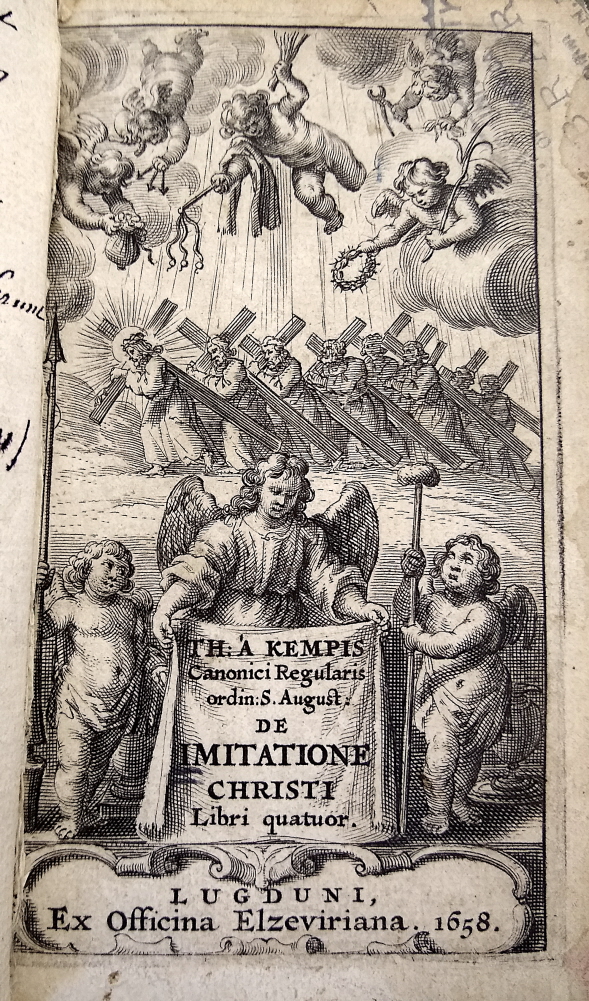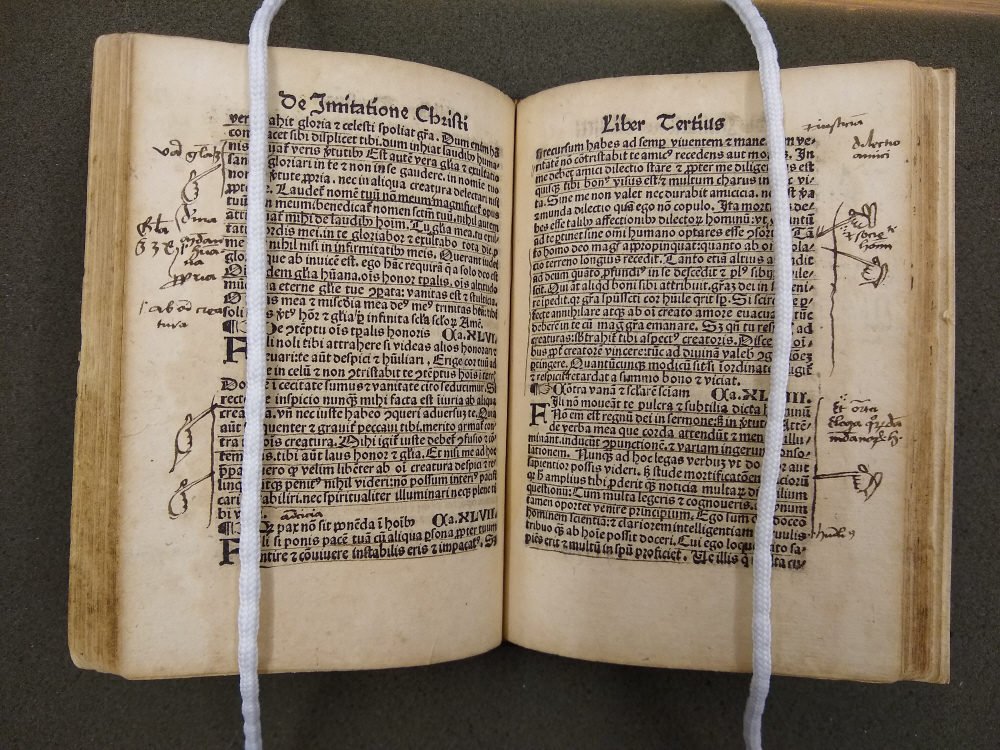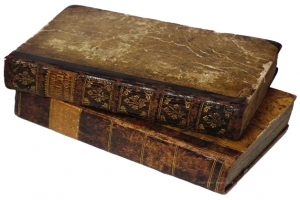
“Why do you need so many copies of the same work in your collection?” Such a question can be easily asked by any patron after finding in the library catalog that Rare Books houses 36 cataloged copies of The Imitation of Christ by Thomas à Kempis. It blows some people’s minds and raises questions: Why so many? Is not one or two copies enough, especially since there are multiple modern editions and translations available in the general stacks?
As the matter of fact, most of the books, pamphlets, and other kinds of resources housed in Rare Books are preserved on our shelves not only because of the text they contain (though this may be the case for some extremely rare or unique editions) but rather because of some other unique or special features of the books as physical objects, such as print and type, binding and tooling, illuminations and miniatures, paper and watermarks, corrections and marginalia (personal notes, images, and doodles left on margins by previous readers), bookplates and inscriptions, association with prominent historical figures, items left between the pages, and many more. Similar to twins, that develop unique features of their look and character as they grow, so the books even if they came out of the same printing press on the exact same day, will differ significantly in their appearance and each will have its own story to tell.
Scholars in various disciplines study rare books as objects that possess historical, evidential, and informational value through their physicality. They can provide insights on the history of book printing and binding, circulation and ownership, reading habits and purposes (both recreational and educational), aesthetic preferences, changes in society, and more. That’s what makes our books special: they are always ready to give a personal witness to the past.

“The Imitation of Christ” is one of such popular works translated and reproduced abundantly through the centuries. It has always and continues to be deeply respected, loved, read, studied, and praised by many, religious and laypeople, artists and soldiers, and novelists and scholars alike. It has brought comfort to many historical figures, such as St. Theresa of Avila, George Eliot, Thomas Merton, and St. Thomas More, who, according to some, had a copy of The Imitatio with him while waiting for his execution, as well as fictional characters such as Agatha Christie’s Miss Marple, who used to keep a copy at her bedside and read a few chapters every night. But the main reason, it has been chosen as the hero of this story is its astounding 600 years jubilee which we celebrate today.
Well, not exactly “today,” for we do not know the year in which De Imitatione Christi was composed. Various scholars agree only on the timeframe between 1410 and 1425, which gives us still plenty of time to commemorate the date and salute this great work. Though it first appeared anonymously, De Imitatione Christi is now commonly attributed to a German-Dutch canon regular and member of the modern devotional movement (aka Devotio Moderna) Thomas Hemmerken from the town of Kempen, better known as Thomas à Kempis (c. 1380 – 1471).
In homage to his inspirational work, we’d like to highlight today three of our special copies of The Imitation of Christ, offering also a glimpse into Rare Books holdings and encouraging everyone interested to come and see the original volumes in person.

A copy with a secret (Cologne, Germany, 1503)
Various museums and libraries in the U.S. and overseas preserve peculiar books that have a hidden compartment in their bindings. Sometimes it can be as wild as a place to hide a pistol. Our volume is not a book of a criminal or a smuggler, but rather of an early 16th-century passionate reader, who just wanted a convenient spot to keep their reading spectacles and to never have to ask one of the eternal questions of mankind: “where did I put my glasses?”
An annotated copy (Cologne, Germany, 1507)
There are always people who like to make notes on the margins of a paper book one studies deeply: agreeing or arguing with the author, developing their own ideas about the topic, or recording insights and expanding the perspective. That is one of the ways to collaborate with the author and create a personal relationship with the book: both, the work and the object (Though we don’t encourage it in any other than one’s own books!). Another of our early 16th-century copies of the Imitatio, which was previously part of the collection of a book lover and our great donor Msgr. Arthur Connolly, holds marginal notes of a scholar who was deeply immersed in the text. It’s still waiting for its researchers who would like to transcribe and study the thoughts and insights of this early reader of the Imitation of Christ.
The Musica Ecclesiastica (New York, 1891)
As a devotional work, The Imitation of Christ was meant to be not only studied by the educated but read and put into practice by anyone. To assist with that, there were numerous attempts conducted to translate it from Latin into vernacular languages making it accessible to everyone. There are multiple translations of the Imitatio known and available today, but in this unique late 19th-century American edition, the translator, an English theologian, Oxford professor, and a personal friend of Lewis Carroll, H. P. Liddon, endeavored to preserve its original beauty. According to him, the Imitatio was also called “Musica Ecclesiastica” or “The Church Music”, because of the rhythm and melody of the original Latin, which the translator wished to catch and preserve. Maybe it’s not as old as other copies that are shown here, but it is trying to be faithful to the original intent of the author as well as is faithful to the spirit of its own time: in its language, appearance, binding, and other features.
Each one of these books, as well as any other copy of The Imitation of Christ in our collection, can be accessed by appointment in Rare Books (Mullen 214, lib-rarebooks@cua.edu) by any patron or researcher interested in studying them more closely.
Sources:
- Becker, Kenneth Michael. From the Treasure-House of Scripture: an Analysis of Scriptural Sources in De Imitatione Christi. Turnhout, Belgium: Brepols, 2002.
- Thomas, à Kempis. The complete Imitation of Christ. Translated and commented by Father John-Julian. Brewster, Mass.: Paraclete Press, c2012.
- Thomas à Kempis, De Imitatione Christi, Leiden, 1658
